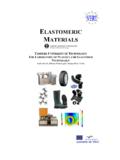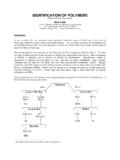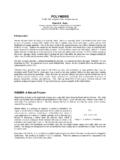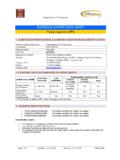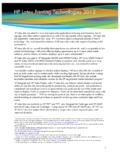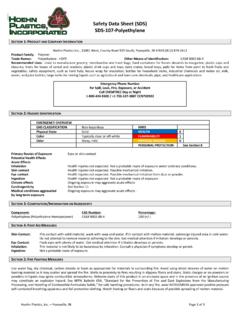Transcription of Polymer Modified Bitumen: Laboratory Evaluation ...
1 Polymer Modified bitumen : Laboratory Evaluation , construction guidelines And Field Experience Gayle N. King, Chief Chemist, Elf Asphalt, Inc. Helen W. King, Laboratory Supervisor, Elf Asphalt, Inc. Presented to the Third International Road Federation Middle East Regional Meeting, Riyadh, Saudi Arabia, February, 1988. 1 Polymer Modified bitumen : Laboratory Evaluation , construction guidelines AND FIELD EXPERIENCE ABSTRACT The abundance of asphalt compatible polymers now available makes it possible to improve almost every aspect of paving. It is crucial, however, that the various physical characteristics, construction constraints, and ultimate cost-benefits be understood.
2 To this end, numerous standards for quality testing and specification are under development. Comparative Polymer Modified bitumen trials are currently being planned and executed in many states. Recently polymers have been used for dense-and open-graded hot mix, hot and cold recycling, hot applied and emulsion surface treatments, stress absorbing membranes, slurry seals, joint sealants, and patching materials. Increased durability, improved rutting resistance, better aggregate adhesion, improved temperature susceptibility, improved stiffness moduli, and better overall flexibility are the most beneficial characteristics of Polymer Modified bitumen . INTRODUCTION To meet the demands of technological and demographic changes, the use of Polymer Modified bitumen has become increasingly important.
3 Increased stress on highways due to heavier loads, higher tire pressures, and ever rising traffic counts are causing premature failures. Severe climates, always a source of concern, and an increased emphasis on safety have prompted research towards the amelioration of highway paving materials. As the network of highways ages, the demand for quality maintenance and recycling products is becoming more important than that for new construction . To address these problems, the highway engineer has turned to Polymer modification for custom design of pavement materials. POLYMERS CURRENTLY USED FOR bitumen MODIFICATION bitumen soluble polymers are very large molecules, usually 50 to 500 times the size of a typical asphalt molecule.
4 They can be divided into two major groups: elastomers and plastomers. Rubber products are classic examples of elastomers. Their identifying property is their elasticity over a wide temperature range--the ability to stretch under an applied load and to recover the original configuration once that load is released. 11hile the rubber industry has successfully designed all-weather tires, the asphalt engineer has had to carefully choose from a broad range of asphalt grades to meet each specific climatic and traffic condition. The introduction of natural or synthetic rubbers such as styrene-butadiene rubber (SBR) , styrene-butadiene block copolymer (SB,SBS), styrene-isoprene (SI), and 1 polychloroprene gives the asphalt increased flexibility, particularly at the climatic extremes where most pavement damage occurs.
5 Plastomers are employed to t~ce advantage of the strength imparted by a rigid three-dimensional chemical network. Plastics are stronger but less flexible -than their elastomeric counterparts. Products such as ethyl-vinyl-acetate (EVA), polyethylene/polypropylene, ethylene propylene (EPDM), and polyvinyl chloride (PVC) significantly raise the stiffness of a bitumen without sacrificing the low temperature performance. BINDER TESTING To identify the unique properties given by polymers and to eliminate ineffective ones, a series of new physical tests must be used to complement the existing standards for bitumen specification. Because the properties of each Polymer are specific to its chemical and physical structure, it cannot be assumed that one standard is applicable to all polymers.
6 The conventional tests such as penetration, absolute viscosity at 60 C (140 F), kinematic viscosity at 135 C (275 F), softening point, etc., while valuable, cannot effectively characterize Modified binders because the fluid dynamics of Polymer solutions are very different from those of asphalt. The Modified rheological behavior (for example the decreased temperature susceptibility, increased elasticity and pseudo-plasticity), is the major reason for using polymers. While the classic asphalt tests do not adequately differentiate these characteristics, methods adapted from those used by the Polymer industry do. For example, the testing of tensile strength during elongation, elastic response after removal of an applied load and rheological measurements made at the temperature extremes and stress conditions found on highways are necessary for identifying properties such as elastic modulus, loss angle, material strength maintained during deformation, and temperature susceptibility.
7 We outlined some useful experimental methods for characterizing and specifying Polymer - Modified Asphalt Cement (PAC) in an earlier paper (1). Included are sophisticated methods suitable for the research Laboratory , as well as simple, inexpensive procedures adaptable for field testing. Some of these are summarized below. Tensile strength during elongation may be measured by using tension tests (ASTM D-412)(2), force ductility (recently proposed to comnlittee D-04 of ASTM by Don O'Conner of the Texas DOT)(3)(4)(5), toughness and tenacity (6), or dropping ball (7). The elasticity can be measured easily by monitoring the elastic recovery in a ductilometer (8)(1) or by using the Torsional Recovery Test (9)(10).
8 (Author's note: we prefer to modify this last test by holding the 180 degree deformation for 30 seconds and then measuring the entire recovery angle 2 after the cylinder is released. ) vihile these methods are effective for measuring elastomeric properties, they may not be applicable to plastomers. A more complete rheological picture detailing the viscous and elastic moduli can be obtained from dynamic (multiple loading cycle) rheometers such as the Rheometries spectrophotometer (11) or similar devices (12)(13)(1~). Static methods, which entail only one loading cycle, include the Modified sliding plate rheometer as developed by the Australian road research board (15), the Dekker falling concentric cylinder rheometer (16), and the thin-film sliding plate rheometer developed by the French Highway Laboratories (17)(18).
9 To demonstrate the improvement in cohesion, a vial it pendulum test measures the angle to which a pendulum rises after dislodging a metal plate inserted in a bitumen (19). A measure of the temperature susceptibility is given by the difference between the softening point and Frass point, sometimes called the plasticity range. Alternative temperature susceptibility measurements include Pen-Vis numbers (20), Penetration Index, and the slope of viscosity-temperature curves. TESTING OF BINDER WITH AGGREGATE In recent years the factors listed in the introduction as prompting the development of Polymer Modified bitumen have also encouraged the development of Laboratory tests which more faithfully predict the quality of an asphalt-aggregate mix.
10 Most of these tests focus on a measurement of resistance to the factors commonly causing failures: rutting, ravelling, cracking, fatigue, stripping, etc. In conjunction with classic specification tests, these new procedures are useful in predicting the relative merits of various Polymer systems. A detailed discussion relating the binder rheology to mix properties may be found in an earlier paper (21). An increased resistance to permanent deformation is perhaps the most universal advantage of polymers; the elastomers have the ability to recover after a load, and the plastomers have increased flexural strength. Preliminary creep compliance data indicate this permanent deformation resistance of polymers is most pronounced under long loading times, such as those encountered in slow moving traffic (22).

